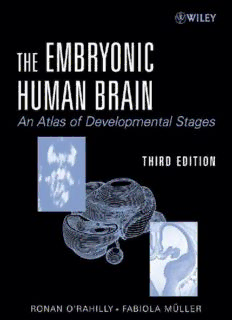
The Embryonic Human Brain An Atlas Of Developmental Stages PDF
Preview The Embryonic Human Brain An Atlas Of Developmental Stages
THE EMBRYONIC HUMAN BRAIN The brain at the end of the embryonic period (stage 23, 8 postfertilizational weeks). The color scheme used here (telencephalon in yellow, diencephalon in blue, mesencephalon in brown) will be repeated in a number of illustrations throughout the book. THE EMBRYONIC HUMAN BRAIN AN ATLAS OF DEVELOPMENTAL STAGES THIRD EDITION RONAN O’RAHILLY, M.D., D.Sc., Dr.h.c. ¨ FABIOLA MULLER, Dr.habil.rer.nat. School of Medicine University of California at Davis Davis, California and Institut d’Embryologie Spe´ciale Universite´ de Fribourg, Fribourg, Switzerland A JOHN WILEY & SONS, INC., PUBLICATION Illustrationsonthecover: Ultrasonicinvivoimageat6weeksshowingthefourthventricle. cf.Fig.23-35.CourtesyofDr.Harm-GerdBlaas. Perspektomatreconstructionat8weeks,stage23. SeeFig.2-1. Obliquesectionat7weeks,stage20. SeeFig.20-4. Copyright(cid:1)C 2006byJohnWiley&Sons,Inc.,Hoboken,NJ.Allrightsreserved. PublishedsimultaneouslyinCanada Nopartofthispublicationmaybereproduced,storedinaretrievalsystem,ortransmittedinanyformorbyanymeans,electronic,mechanical, photocopying,recording,scanning,orotherwise,exceptaspermittedunderSection107or108ofthe1976UnitedStatesCopyrightAct,without eitherthepriorwrittenpermissionofthePublisher,orauthorizationthroughpaymentoftheappropriateper-copyfeetotheCopyrightClearance Center,Inc.,222RosewoodDrive,Danvers,MA01923,(978)750-8400,fax(978)750-4470,oronthewebatwww.copyright.com.Requeststothe PublisherforpermissionshouldbeaddressedtothePermissionsDepartment,JohnWiley&Sons,Inc.,111RiverStreet,Hoboken,NJ07030,(201) 748-6011,fax(201)748-6008,oronlineathttp://www.wiley.com/go/permission. LimitofLiability/DisclaimerofWarranty:Whilethepublisherandauthorhaveusedtheirbesteffortsinpreparingthisbook,theymakeno representationsorwarrantieswithrespecttotheaccuracyorcompletenessofthecontentsofthisbookandspecificallydisclaimanyimplied warrantiesofmerchantabilityorfitnessforaparticularpurpose.Nowarrantymaybecreatedorextendedbysalesrepresentativesorwrittensales materials.Theadviceandstrategiescontainedhereinmaynotbesuitableforyoursituation.Youshouldconsultwithaprofessionalwhere appropriate.Neitherthepublishernorauthorshallbeliableforanylossofprofitoranyothercommercialdamages,includingbutnotlimitedto special,incidental,consequential,orotherdamages. Forgeneralinformationonourotherproductsandservicesorfortechnicalsupport,pleasecontactourCustomerCareDepartmentwithinthe UnitedStatesat(800)762-2974,outsidetheUnitedStatesat (317)572-3993orfax(317)572-4002. Wileyalsopublishesitsbooksinavarietyofelectronicformats.Somecontentthatappearsinprintmaynotbeavailableinelectronicformats.For moreinformationaboutWileyproducts,visitourwebsiteatwww.wiley.com. LibraryofCongressCataloging-in-PublicationData: ISBN-13:978-0-471-69462-5 ISBN-10:0-471-69462-2 PrintedintheUnitedStatesofAmerica 10 9 8 7 6 5 4 3 2 1 In memory of Ernest Gardner, M.D., neuroscientist, colleague, and friend ...ce feroit vn grand bon-heur pour le genre humain, fi cette partie, qui eft la plus delicate de toutes, & qui eft fujette ´a des maladies tres-frequentes, & tres-dangereufes, eftoit auffi bien connue¨, que beaucoup de Philofophes & d’Anatomiftes fe l’imaginent. Niels Stensen, Discovrs svr 1’Anatomie du cerveau, 1669. CONTENTS Preface to the Third Edition ix 1. Historical Aspects 1 2. Techniques 5 3. Prenatal Measurements 9 4. Embryonic Staging 11 5. Prenatal Age 15 6. Terminology 17 7. Early Stages 21 8. Stage 8: The First Appearance of the Nervous System 25 9. Stage 9: The Major Divisions of the Brain 31 10. Stage 10: The Neural Tube and the Optic Primordium 39 11. Stage 11: Closure of the Rostral Neuropore 51 12. Stage 12: Closure of the Caudal Neuropore and the Beginning of Secondary Neurulation 61 13. Stage 13: The Closed Neural Tube and the First Appearance of the Cerebellum 75 14. Stage 14: The Future Cerebral Hemispheres 84 15. Stage 15: Longitudinal Zoning in the Diencephalon 93 16. Stage 16: Evagination of the Neurohypophysis 103 17. Stage 17: The Future Olfactory Bulbs and the First Amygdaloid Nuclei 115 18. Stage 18: The Future Corpus Striatum, the Inferior Cerebellar Peduncles, and the Dentate Nucleus 133 19. Stage 19: The Choroid Plexus of the Fourth Ventricle and the Medial Accessory Olivary Nucleus 149 20. Stage 20: The Choroid Plexus of the Lateral Ventricles, the Optic and Habenular Commissures, and the Interpeduncular and Septal Nuclei 169 21. Stage 21: The First Appearance of the Cortical Plate in the Cerebral Hemispheres 187 22. Stage 22: The Internal Capsule and the Olfactory Bulbs 205 23. Stage 23: The Brain at the End of the Embryonic Period 219 24. Trimester 1, Postembryonic Phase 263 Early Postembryonic Phase 265 Later Postembryonic Phase 285 25. Trimester 2 297 vii viii CONTENTS 26. Trimester 3 and the Newborn 305 Supplement: Early Postnatal Life 319 Bibliography 323 Glossary 331 Appendix 1: Changing Lengths of the Brain and its Subdivisions from 31/ to 51/ 2 2 Weeks (Stages 9–16) 341 Appendix 2: Computer Ranking of the Sequence of Appearance of Features of the Brain 343 Appendix 3: Sequence and Stage of Appearance of Median Features of the Brain 349 Appendix 4: Sequence and Stage of Appearance of Tracts of the Brain 351 Appendix 5: Sequence and Stage of Appearance of Features Associated with the Rhombencephalon 353 Index 354 PREFACE TO THE THIRD EDITION T hemainobjectivesofthismonographaretoprovide Theauthors’schemeoftheneuromeres,whichdiffers andtointerpretdrawings,photographs,andphotomi- fromothersinbeingbasedonthehuman,isdetailedhere. crographs of the human embryonic brain. The drawings Other topics emphasized include segmentation, not only includeatleastalateralviewandamedianreconstruction oftheneuralaxisbothrostrallyandcaudally,butalsothat ofthebrainateachstage,aswellasaclearindicationofthe ofoccipitocervicaldifferentiation.Stemandcrestcellsin planeofsectionoffurtherillustrations,eitherdrawingsor the olfactory region are elaborated, and the cerebellum, photomicrographs. Summarizing statements of the mor- theamygdaloidcomplex,thehippocampalregion,andthe phological status of the brain at each stage are supplied, corpusstriatumaregivenspecialattention. andbriefstatementsconcerningrelevantanomalouscon- This edition has been enhanced by the use of color, ditionsareincluded. as well as by the inclusion of more that 100 new illus- Theembryonicperiodproper(thefirsteightpostfer- trationsand26newtables.Moreover,somerepresentative tilizationalweeks)isparticularlyimportantbecause(1)the examplesofultrasonicimageshavebeeninterspersed.The embryonicbrainisextremelydifficulttocomprehendand definitionsformerlygiveninChapter6havebeenexpanded to visualize, (2) serial sections of first-class quality that considerablyandcollectedasanimportantGlossarynear show the human embryonic brain are rarely accessible, theendofthebook. and (3) most major congenital anomalies appear during The Bibliography has been enlarged and brought up that time. A briefer account of the fetal period has been todate.Itcomprisesmorethan350referencestothechief includedandemphasizesthecontinuityofdevelopment. studiesoftheprenatalhumanbrain.Theprofuseliterature Despite a general, superficial similarity in the devel- relatingtootherspecies,however,isbeyondthescopeof opment of the brains of various vertebrates, significant, thisbook. subtledifferencesexistsothat,undoubtedlyimportantas A set of standardized abbreviations, mostly self- arethefindingsinotherspecies,contributionsspecifically evident,isusedthroughoutfortheillustrations,andalist to the prenatal human brain are as essential as they are ofthemisplacedimmediatelyinsidethefrontcover. fascinating. The number assigned to chapters 8–23 and the first The external and internal structure of the develop- number given to each illustration indicate the develop- ingbrain,theprimaryconcernofthisbook,isanessential mentalstage. prolegomenonforsubsequentinvestigationsrangingfrom The authors wish to acknowledge the valuable sup- immunocytochemistrytoimaginginvivo.Structuralrep- portfortheirresearchprovidedbytheU.S. NationalInsti- resentation, however, needs to be completed by interpre- tutesofHealthovermanyyears.Exceptwhereotherwise tation. In the present context two necessary components indicated, the photomicrographs as well as many of the ofpreciseinterpretationare(1)morphologicalstaging(as photographsarefromtheCarnegieCollection.Thescan- distinct from mere seriation, such as length or supposed ningimagesareincludedthroughthekindnessofDr.med. age),withoutwhichindividualeventscannotbearranged Harm-GerdBlaasandothercolleagueswhoarecreditedin in correct sequence, and (2) accurate three-dimensional theappropriateplaces.ItisapleasuretothankallatWiley- reconstructions,withoutwhicherroneousassumptionsof Lissfortheirencouragementandassistance. interpretation can be (and frequently are) made. These desiderata, which have been used by the authors in their RONANO’RAHILLY research over many years, are a unifying feature of this FABIOLAMU¨LLER treatise: (1) the Carnegie system of staging originated by Villars-surGlaˆne,Switzerland Streeterandnamedanddevelopedbytheauthorsisfunda- July2006 mentaltothepresentation,and(2)mostofthedrawings here are based on extremely precise graphic reconstruc- tionspreparedbytheauthors.Nosimilarworkisavailable. ix
Description: